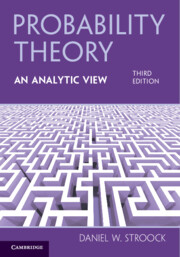Refine search
Actions for selected content:
3044 results in Probability theory and stochastic processes
6 - Some Extensions and Applications of Martingale Theory
-
- Book:
- Probability Theory, An Analytic View
- Published online:
- 07 November 2024
- Print publication:
- 21 November 2024, pp 200-234
-
- Chapter
- Export citation
Contents
-
- Book:
- Probability Theory, An Analytic View
- Published online:
- 07 November 2024
- Print publication:
- 21 November 2024, pp vii-xii
-
- Chapter
- Export citation
7 - Continuous Parameter Martingales
-
- Book:
- Probability Theory, An Analytic View
- Published online:
- 07 November 2024
- Print publication:
- 21 November 2024, pp 235-263
-
- Chapter
- Export citation
3 - Infinitely Divisible Laws
-
- Book:
- Probability Theory, An Analytic View
- Published online:
- 07 November 2024
- Print publication:
- 21 November 2024, pp 101-130
-
- Chapter
- Export citation
5 - Conditioning and Martingales
-
- Book:
- Probability Theory, An Analytic View
- Published online:
- 07 November 2024
- Print publication:
- 21 November 2024, pp 170-199
-
- Chapter
- Export citation
9 - Convergence of Measures on a Polish Space
-
- Book:
- Probability Theory, An Analytic View
- Published online:
- 07 November 2024
- Print publication:
- 21 November 2024, pp 304-333
-
- Chapter
- Export citation
1 - Sums of Independent Random Variables
-
- Book:
- Probability Theory, An Analytic View
- Published online:
- 07 November 2024
- Print publication:
- 21 November 2024, pp 1-50
-
- Chapter
- Export citation
2 - The Central Limit Theorem
-
- Book:
- Probability Theory, An Analytic View
- Published online:
- 07 November 2024
- Print publication:
- 21 November 2024, pp 51-100
-
- Chapter
- Export citation
Preface
-
- Book:
- Probability Theory, An Analytic View
- Published online:
- 07 November 2024
- Print publication:
- 21 November 2024, pp xiii-xix
-
- Chapter
- Export citation
Dedication
-
- Book:
- Probability Theory, An Analytic View
- Published online:
- 07 November 2024
- Print publication:
- 21 November 2024, pp v-vi
-
- Chapter
- Export citation
Index
-
- Book:
- Probability Theory, An Analytic View
- Published online:
- 07 November 2024
- Print publication:
- 21 November 2024, pp 440-446
-
- Chapter
- Export citation
8 - Gaussian Measures on a Banach Space
-
- Book:
- Probability Theory, An Analytic View
- Published online:
- 07 November 2024
- Print publication:
- 21 November 2024, pp 264-303
-
- Chapter
- Export citation
4 - Lévy Processes
-
- Book:
- Probability Theory, An Analytic View
- Published online:
- 07 November 2024
- Print publication:
- 21 November 2024, pp 131-169
-
- Chapter
- Export citation
Frontmatter
-
- Book:
- Probability Theory, An Analytic View
- Published online:
- 07 November 2024
- Print publication:
- 21 November 2024, pp i-iv
-
- Chapter
- Export citation
11 - Some Classical Potential Theory
-
- Book:
- Probability Theory, An Analytic View
- Published online:
- 07 November 2024
- Print publication:
- 21 November 2024, pp 384-436
-
- Chapter
- Export citation
Notation
-
- Book:
- Probability Theory, An Analytic View
- Published online:
- 07 November 2024
- Print publication:
- 21 November 2024, pp xx-xxii
-
- Chapter
- Export citation
References
-
- Book:
- Probability Theory, An Analytic View
- Published online:
- 07 November 2024
- Print publication:
- 21 November 2024, pp 437-439
-
- Chapter
- Export citation
10 - Wiener Measure and Partial Differential Equations
-
- Book:
- Probability Theory, An Analytic View
- Published online:
- 07 November 2024
- Print publication:
- 21 November 2024, pp 334-383
-
- Chapter
- Export citation

Probability Theory, An Analytic View
-
- Published online:
- 07 November 2024
- Print publication:
- 21 November 2024
Preface
-
- Book:
- Groups and Graphs, Designs and Dynamics
- Published online:
- 11 May 2024
- Print publication:
- 30 May 2024, pp xiii-xvi
-
- Chapter
- Export citation
